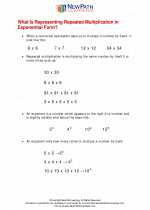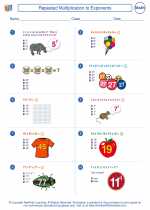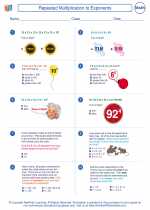Repeated Multiplication to Exponents
Explanation
In mathematics, when a number is multiplied by itself several times, we can use exponents to represent the repeated multiplication. An exponent is a small number placed to the upper right of another number, indicating how many times that number should be multiplied by itself.
For example, in the expression 23, the base number is 2 and the exponent is 3. This means that we need to multiply 2 by itself 3 times: 2 x 2 x 2, which equals 8.
Rules for Repeated Multiplication to Exponents
When using repeated multiplication to exponents, there are some important rules to keep in mind:
- Multiplying Powers with the Same Base: When multiplying powers with the same base, you can add the exponents. For example, 23 * 24 = 27 because 3 + 4 = 7.
- Dividing Powers with the Same Base: When dividing powers with the same base, you can subtract the exponents. For example, 25 ÷ 23 = 22 because 5 - 3 = 2.
- Raising a Power to a Power: When raising a power to a power, you can multiply the exponents. For example, (23)2 = 26 because 3 * 2 = 6.
Study Guide
Here are some steps to help you master the concept of repeated multiplication to exponents:
- Practice writing out and solving basic exponent expressions, such as 24 or 35.
- Understand the relationship between the base number and the exponent in an exponential expression.
- Practice applying the rules for multiplying, dividing, and raising powers to powers.
- Solve a variety of problems involving exponents to reinforce your understanding of the concept.
Remember, mastering the concept of repeated multiplication to exponents can help you solve complex mathematical problems and make calculations more efficient.
[Repeated Multiplication To Exponents] Related Worksheets and Study Guides:
.◂Math Worksheets and Study Guides Sixth Grade. Repeated Multiplication to Exponents

 Worksheet/Answer key
Worksheet/Answer key
 Worksheet/Answer key
Worksheet/Answer key
 Worksheet/Answer key
Worksheet/Answer key
